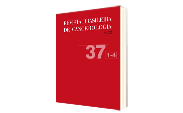Study models for inducing tumors by 7,12-dimethylbenz (A) - Antracene in rat mammary gland
DOI:
https://doi.org/10.32635/2176-9745.RBC.1991v37n1/4.3103Keywords:
Breast Cancer, DMBA, rat mammary gland, study modeisAbstract
Five study models (A, B, C, D, E) were used to investigate the effect of 7, 12-dimethylbenz(a)anthracene in inducing tumors in the mammary tissue of Spreague-Dawiey rats. Each group was subjected ad libitum to the foiiowing diets: group A - commercial ration; groups B/C - a semipurified linoleic acid-rích diet; group D - a semipurified saturated fatty acid-rich diet; group E - a semipurified fat diet composed of 50% soybean 0ff (rich in essential fatty acid), 25% olive oil (rich in oleic acid) and 25% coconut oil (rich in saturated fatty acid). The animais were fed through intragastric instiiation, one or two doses of DMBA dissolved in 1 ml of soybean oil Group A animais received a single 10 mg-DMBA-doses 60 days after birth. Group 8 animals received two-20 mg-DMBA -doses, the first dose 45 days after birth and the second 60 days after birth. Groups C, D and E animais were treated in the same way as group 8 animais. The control-groups were fed 1 mi-piacebo-soybean oiL DMBA induced tumors in the treated rats as visualized in the following results: 1) Groups A, B, C, O and E developed 52%, 76%, 88%, 60% and 67% tumors, respectively; 2) in the test groups A, B, C, D and E the first paipabie tumor was reported at 200 ± 52, 103 ± 36, 48 ± 1, 133 ± 62 and 183 ± 45 days after DMBA administration, respectively. 3) 14.8%, 40.7%, 97.5%, 50.0% and 41.7% of all tumors were classified as adenocarcinoma.The results suggest that study model "C" was the most effective one, inducing higher incidence of adenocarcinomas in DMBA-treated-rats, the symptons being evidenced in the shortest experimental time.
Downloads
References
HUGGINS C, BRIZIARELLI G, SUTTON H. Rapid induction of mammary carcinoma in the rat and the influence of hormone on the tumors. J Exp Mcd 1959; 109: 25-54. DOI: https://doi.org/10.1084/jem.109.1.25
HUGGINS C, GRANO LC, BRILLANTES FP. Mammary cancer induced by a single feeding of polynuclear hydrocarbons and its supression. Nature 1961; 189: 204-207. DOI: https://doi.org/10.1038/189204a0
DIGIOVANNI J, JUCHAU MR. Biotransformation and bioactivation of 7, 12-dimethylbenz(a)anthracene (7,12-DMBA). Drug Metab Ver 1980; 11(1):61-101. DOI: https://doi.org/10.3109/03602538008994022
MILLER EC. Some current perspectives on chemical carcinogenesis in humans and experimental animals: presidential address. Cancer Res 1978; 38: 1479-1496.
RUSSO J, WILGUS G, RUSSO 1H. Susceptibility of the mammary gland to carcinogenesis. 1. Differentiation of the mammary gland as determinant of tumor incidence and type of lesion. Am J Pathol 1979; 96: 721-736.
PURNELL DM. The relationship of terminal duct hyperplasia to mammary carcinoma in 7, 12-dimethylbenz(a)anthracene-treated LEW/ Mai rats. Am J Pathol 1980; 98:311-324.
ALVARENGA M, CAVALCANTI TC, TAHIN OS. Histopathologic grading system for epitelial abnormalities induced by 7,12-dimethylbcnz(a)anthracene (DMBA) in female rat mammary tissue. Breast Dis 1989; 2:71-79.
CARROLL KK, GAMMAL EB, PLUNKTT ER. Dietary fat and mammary cancer. Cand Mcd Ass J 1968; 98: 590-594.
CARROLL KK. Summation: which fat/how much fat animaIs. Prev Mcd 1987; 16: 510-515. DOI: https://doi.org/10.1016/0091-7435(87)90065-X
KRITCHEVSKY D. Lipids and cancer. In: Arnott MS, van Eys J, Wang Y-M, eds. Molecular Interrelations of Nutrition and Cancer. NewYork: Raven Press 1982: 209-217.
ABRAHAM S, FAULKIN II, HILLYARD LA, MITCHELL DJ. Effect of dietary fat on tumorigenes in the mouse mammary gland. J Nath Cancer lnst 1984; 72(6): 1421-1429.
SELENKAS SL, lP MM, IP C. Similarity between trans fat and saturated fat in the modification of rat mammary carcinogenesis. Cancer Res 1984; 44: 1321-1326.
ABOU-EL-ELA SH, PRASSE HW, CARROLL R, WADE AE, DHARWADKAAR S, BUNCE OR. Eícosanoid synthesis in 7,12- dimethylbenz(a)anthracene-induced mammary carcinoma in Sprague-Dawley rats fed primose, menhaden oil or com oil diets. Lipids 1988; 23: 948-954. DOI: https://doi.org/10.1007/BF02536342
TAHIN OS, CAVALCANTI TC. The effect of dietary lipids in the fatty acid composition of mammary mitochondria of female rat treated with 7,12-dimethylbenz(a)anthracene. Breast Dis 1991; in press.
CARROLL KK. Fish oils and cancer. ln: Chandra RK, ed. Health Etíects of Fish Oils. St. John's, Newtoundland: ARTS Biomedical Publishers & Distributors, 1989:395-408.
JACOBSON EA, JAMES KA, NEWMARK HL, CARROLL KK. Effects of dietary fat, caicium, and vitamin D on growth and ma-mmary tumorigenesis induced by 7,12-dimethylbenz(a)anthracene in female Sprague-Dawley rats. Cancer Res 1989; 49: 6300-6303.
CARROLL KK. Experimental and epidemiological evidence on marine lipids and carcinogenesis. ri: Less RS, Karol M. eds. Omega-3 fatty acids in health and disease, New York: Marcel Dekker Inc., 1990: 99-114. DOI: https://doi.org/10.1201/9781003066453-5
RUSSO J, RUSSO IH. Biology of disease. Biological and molecular bases of mammary carcinogenesis. Lab lnvest 1987; 57(2): 112-137.
CAVALCANTI TC, MELLO RA, De CAMARGO AM, TAHIN OS. Mammary mitochondria ATPase of female rats treated by DMBA and two lipid diets. IRCS Mcd Sci 1986: 14: 1161-1162.










